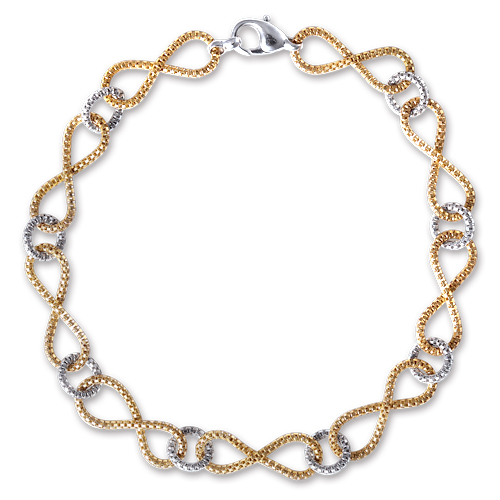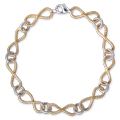
Felisa Princess Necklace
Senorita in Style
Felisa is a Spanish female name meaning the successful and the lucky. Exemplifying a high taste for refinement and fashion that is often associated with success, the Felisa Princess is a creative blend of colour, shape and finesse. Rhodium-plated silver rings hold together yellow gold-plated rollo rings in a series of intricate twists and turns, composing an alluring and striking complement to a woman’s neckline.
Giving you great style paired with magnificent design in high-polish finish, the Felisa Princess Necklace is a fitting reward to celebrate great fortune and make you shine like royalty.
| Necklace: | |
| Content | Silver 925/- with Rhodium and Yellow gold plated |
| Weight | 35.8 g |
| Length | 48.5 cm |
| Style | Rollo and ring with carabine clasp |
Jewellery Care Tips
- With the proper care, precious jewellery should last for decades and remain a valuable possession. By taking good care and applying practical advice, you can safeguard your jewellery and ensure it stays with you forever.
- Protect your jewellery from sharp blows, scratches, chemicals, sunlight and extreme temperatures. Store your jewellery in a soft-lined box or pouch. Try to keep your jewellery pieces apart, so that they don't rub against each other or get tangled up.
- Wear jewellery for appropriate occasions. Avoid wearing rings when doing household chores or engaging in sporting activities. Stones can be knocked loose and jewellery may come in contact with abrasive elements, which discolour the metal.
- Don't let your jewellery come into contact with nail polish removers, perfume or hairspray. This may discolour gold or make pearls turn yellow. Put jewellery on only after you have applied cosmetics or sprays.
- Settings can become clogged with soap and hand cream. Take rings and bracelets off when washing your hands. When using a public lavatory, secure hand rings to your necklace or place them in a pouch inside your handbag or purse.
- Heat and hot water can loosen jewellery settings in which an adhesive has been used. Pearl rings, earrings and pendants have this type of setting, so take extra care with them.
- Never go swimming with your jewellery. Chlorine in swimming pools can cause extensive damage.
- Clean your jewellery periodically. Use a soft toothbrush and warm soapy water to get into any difficult nooks and crannies. You can also purchase a professional jewellery cleaning product. Make sure to read the manufacturer's instructions.
Gold, Platinum and Silver Care Tips
- Like all jewellery, gold should be periodically cleaned and checked for wear and breakage. You can clean it with warm, soapy water or let your jeweller repolish it.
- Platinum jewellery should be cleaned using a prepackaged jewellery cleaner, or have it cleaned professionally by your jeweller. As with all precious jewellery, store pieces separately to avoid scratching.
- Sterling silver will tarnish with time and wear. Polish it by rubbing or buffing with a soft cotton cloth or sunshine cloth. If you store your silver in a plastic bag with an interlocking seal, it will be less prone to becoming tarnished. Some silver jewellery pieces are coated with rhodium, which is designed to make it tarnish resistant. Clean rhodium-coated sterling silver with a soft polishing rag or a fine silver cleaner. Do not use silver dip as it may cause potential damage to the rhodium finish or any inlaid gemstone.
Diamond Care Tips
- Many people think diamonds are indestructible, but special care is still required to protect them from loss or damage.
- While they are resistant to heat, scratches and can be cut only by another diamond, strong impact against a diamond's girdle can cause chipping or abrasion.
- Make sure your diamonds are safely secured in their settings, especially those with claw-set rings. Do not use soft metals like 24k gold. Jewellery with loose stones should be repaired by a jeweller before being worn again.
- Diamonds scratch other jewellery, so keep them wrapped or store them separately, especially from other diamond jewellery.
- Diamonds can be covered by a greasy film caused by dead skin, dust and grit. There are several ways to clean your diamonds, depending on the metal mount it is set in.
- Most diamonds set in gold or platinum can be cleaned in a detergent bath consisting of warm water and a mild household detergent. Gently scrub with a soft, non-metallic brush and rinse in warm water. Wipe with a soft, lint-free cloth. Avoid using cleaning agents that contain abrasives, such as toothpaste.
- Diamonds set in gold alloys with high karat (18k and above) will not be damaged by household chemicals. However, lower karat alloys (14k and below) are subject to stress corrosion by chlorine-based bleach and other cleaning chemicals. Avoid contact between these chemicals and your jewellery.
- Ultrasonic cleaners perform the job with liquids, usually a mixture of ammonia and detergent. It is best to have a professional jeweller clean your diamonds, but for a quick homemade remedy, you can prepare a solution consisting of one-part ammonia to six-parts water.
Gemstone Care Tips
- To minimise jewellery rubbing together, use a jewellery box with different compartments that are well-padded. Or, better still, keep them in their individual boxes.
- Use a proper, manufactured solution to clean gemstones. Such products can be bought from most jewellery outlets. Hard stones such as diamonds, garnets, sapphires, rubies and amethysts can be dipped in a bowl of warm, soapy water and brushed with an old, soft toothbrush. Be careful not to poke under the gemstones as this may dislodge them from their setting. Amber can be cleaned in the same manner, as long as it is dried straight away. Some stones can be quite porous (such as pearls, jade, jet, lapis, emeralds, opal and turquoise), so they should not be dipped in water. Dipping can strip some of these stones of their oils.
- Some stones are also damaged by sunlight. These include:
Amethyst: becomes paler.
Ametrine: may change colour.
Aquamarine: becomes paler.
Aventurine: translucent types often lose colour.
Beryl: brown or orange types may become pale pink.
Citrine: may change colour.
Kunzite: becomes pale or loses colour.
Rose Quartz: becomes paler.
Smoky Quartz: becomes paler.
- Gemstones that are mounted on rings may become loose or rattle. If this occurs, visit your local jeweller before it's too late. It is much cheaper to have the prongs repaired than to replace a gemstone. Prongs are easily 're-tipped' by most jewellers in order to keep the stone secure.
Pearl Care Tips
- Most pearls worn today are cultured, but though cultured pearls have thicker coatings, they are more fragile than other gemstones.
- Pearls consist of an organic material called conchiolin, which is susceptible to acidic substances such as sweat, vinegar, fruit juices and detergents. These acids cause discolouration, loss of lustre, and dissolution of the aragonite crystals that make up the layers of nacre. Clean your pearls immediately to counter these damaging effects. Use a soft, dry, lint-free cloth such as silicon cloth or chamois to wipe your pearls. You can dampen the cloth with water as long as you allow your pearls to air dry before storing them. Stubborn dirt can be washed away with a mild soap solution (try using Ivory Flakes). Placing a drop of olive oil on the cloth can help maintain lustre. Do not use abrasive cloths, ammonia-based cleaners, harsh detergents, or an ultrasonic cleaner for cleaning your pearls.
- Even if pearls are exceptionally cohesive and shockproof, they rank low on the Mohs hardness scale. Avoid permanent scarring caused by contact with sharp objects or rough surfaces.
- Pearl necklaces or bracelets must be restrung at least once a year. Silk or nylon strings absorb sweat and humidity and will either stretch, loosen or suddenly break. If there is space between the pearls, it is an indication that the string must soon be replaced. When having pearls customised into a necklace or bracelet, request the jeweller to leave a knot between each pearl to prevent them from rubbing against each other. This will also ensure that only one pearl will drop if the string breaks.

